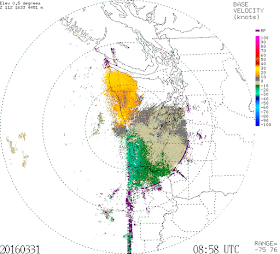It was a classic, with the skies filling with bird echoes right after sunset and then disappearing near sunrise.
Let me show you.
9:30 PM that night. Lots of birds. They don't like to fly offshore. Smart birds.
5 AM. Still there
7:30 AM today (Thusday). They are gone.
Our radars are Doppler radars, which means we can get velocities towards or away from the radar. The Langley Hill radar at 2 AM shows the birds are moving northward, with green colors to the south (approaching) and yellow to the north (going away). Right direction.
A few years ago, the National Weather Service radars were upgraded to dual-polarization, which allows them to tell the shape of "targets." This information can be used to determine what the targets are composed of. Here is the output hydrometeor classification algorithm at 2 AM. It is going for BI or birds (gray color)..undoubtedly, a correct interpretation.
So what kind of weather do birds like to fly in? The famous Cornell Lab of Ornithology has a a wonderful site called BirdCast, which has a lot of this information, including migration forecasts.
According to this site, birds don't like flying in rain (who does?) and they prefer to have winds at their back (ditto).
With a ridge of high pressure over us now, there is no precipitation...so their feathers will be dry.
The winds? Here is a time-height cross section of the winds above Seattle-Tacoma Airport for the period. Time advances from right to left. The vertical axis is height, from sea level up to about 10,000 ft (700 stands for a pressure of 700 hPa). The wind barbs (blue color) show light winds, from varied directions. Time is in UTC (GMT). Good conditions for birds. So with ideal weather in early spring, the birds were ready to move northward last night.
__________________________
Talk announcement:
| "El Niño, and the Rise of the Pacific as Global Climate Pacemaker" Thursday, April 7, 2016 7:30 – 8:30 p.m.
|









Awesome, Cliff.
ReplyDeleteBirds of feather
ReplyDeleteflock together....
As a birder, I am most impressed with this.
ReplyDeleteThank you.
I've been waiting for this post, Cliff. Thanks!
ReplyDeleteSome of the more interesting info I find here, IMHO.
Very cool!
THis is cool.
ReplyDeleteI feel like you cover the migration every year, Cliff, showing us the radar signatures and talking about the conditions that favor a good migration. Some people might be annoyed by repeating topics, but every year, you add a bit more information, and I am always delighted by this convergence of birding and weather. :-)
ReplyDeleteFascinating as usual. Does our radar indicate altitude of birds? Do they typically fly all together at generally the same altitude or is it usually scattered? How does this this impact air traffic control routing, if at all?
ReplyDeleteThe RSVP link for the talk on Apr 7 seems to be broken. We'd love to attend though (2 of us)
ReplyDeleteIs this an april fools joke Cliff?
ReplyDeleteIf not, its very cool!!
Not only is this fascinating, but so, so perfect! Woke up to our returning Osprey male sitting on his tree. Next to him, the Barn Swallows flitted about. Then on the drive towards the Hood Canal, the returning Great Blues were sitting in their rookery...all 24 of them! Am-a-zing. Thank you for the photos of the radar. So dang cool. ~Karen@eutoposfarm.com
ReplyDelete